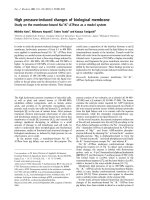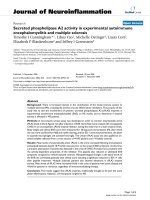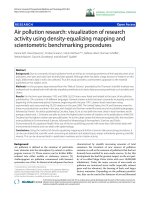Báo cáo hóa học: " High Methanol Oxidation Activity of Well-Dispersed Pt Nanoparticles on Carbon Nanotubes Using Nitrogen Doping" docx
Bạn đang xem bản rút gọn của tài liệu. Xem và tải ngay bản đầy đủ của tài liệu tại đây (556.82 KB, 6 trang )
NANO EXPRESS
High Methanol Oxidation Activity of Well-Dispersed Pt
Nanoparticles on Carbon Nanotubes Using Nitrogen Doping
Wei-Chuan Fang
Received: 9 June 2009 / Accepted: 24 September 2009 /Published online: 9 October 2009
Ó to the authors 2009
Abstract Pt nanoparticles (NPs) with the average size of
3.14 nm well dispersed on N-doped carbon nanotubes
(CNTs) without any pretreatment have been demonstrated.
Structural properties show the characteristic N bonding
within CNTs, which provide the good support for uniform
distribution of Pt NPs. In electrochemical characteristics,
N-doped CNTs covered with Pt NPs show superior current
density due to the fact that the so-called N incorporation
could give rise to the formation of preferential sites within
CNTs accompanied by the low interfacial energy for
immobilizing Pt NPs. Therefore, the substantially enhanced
methanol oxidation activity performed by N-incorporation
technique is highly promising in energy-generation
applications.
Keywords Methanol oxidation activity Á N-doped carbon
nanotubes Á Energy-generation applications
Introduction
Hybrid nanocomposites containing carbon nanotubes
(CNTs) have attracted much attention when each constit-
uent component provides different functions for specific
applications [1]. Although the properties of some CNT-
containing nanocomposites have been investigated [2], the
interface and transport issues in systems still remain a
challenge, particularly in electrochemical (EC) systems [3].
As shown from previous studies, CNTs have great potential
as electrode materials in direct methanol fuel cells
(DMFCs) [4]; however, the surface of CNTs is chemically
inert and therefore the uniform dispersion of metal nano-
particles (NPs) is impossible. It is necessary to modify the
CNTs prior to the support for capturing electrocatalysts
such as Pt- or Pt-based NPs [5, 6]. In general, the chemical
modification is accomplished by acid oxidation using some
oxygen-containing functional groups [7, 8]. These routes
are obviously complicated and result in the formation of
pollutants. Meanwhile, the mechanical properties of mod-
ified CNTs are affected as well.
Recently, chemical doping of CNTs is an attractive
proposition for a wide range of potential applications.
Extrinsic doping of the tube surfaces can give rise to the
formation of localized electronic states [9] and makes the
tubes chemical active; hence, N-doped CNTs are less stable
than their pure carbon counterparts, breaking easily [10]
and oxidizing at lower temperature than undoped CNTs
[11] due to the fact of nitrogen atoms as localized defects,
which will be energetically less stable than a pure carbon
lattice. Moreover, it will make CNT surfaces chemically
active by chemical modification [12]. Their active surfaces
mean they can be dispersed in a range of solvents not
possible with undoped tubes [13]. On the other hand, it is
found that N-doped CNTs only show the metallic behavior
with a strong donor peak just above the Fermi level [14],
unlike undoped CNTs which exhibit a variety of metallic
and semiconducting behavior depending on their chirality.
Doping provides a way to activate regions along the tube
wall and surface reactivity is increased. This opens up the
possibility of doping techniques not available in traditional
three-dimensional materials, notably chemical functionali-
zation of tubes, tube coating with metal ions [15, 16].
Accordingly, it suggests that the concept of N incorpora-
tion would be critical in chemical modifications of CNTs.
W C. Fang (&)
Materials and Chemical Research Laboratories, Industrial
Technology Research Institute, Chutung 310, Taiwan
e-mail:
123
Nanoscale Res Lett (2010) 5:68–73
DOI 10.1007/s11671-009-9444-1
These properties possessed by N-doped CNTs could render
a new type of desirable catalyst support and electrode
material in DMFCs.
In this work, we have developed a simple chemical
method to directly immobilize Pt NPs on N-doped CNTs
without any pre-surface modification. The electrocatalytic
properties of Pt-loaded N-doped CNTs for methanol oxi-
dation are examined and an obvious catalytic activity is
obtained, indicating their potential ability in energy-
generation applications.
Experimental
Synthesis of Nanocomposites
For CNT array preparation, Fe film was deposited on Si
substrates by sol–gel method as catalyst prior to CNTs
growth step. Then, aligned CNTs were grown on the pre-
coated substrates by microwave plasma-enhanced chemi-
cal-vapor deposition (MPECVD). The MPECVD growth
was performed with microwave power at 2 kW; CH
4
,N
2
,
and H
2
as source gases; and the substrate temperature of
1000 ° C. To study N-doping effect, N
2
gas was not fed into
the chamber during CNTs growth. For Pt deposition, DC
sputtering under Ar gas flow was performed.
Characterization
For material analyses, a JEOL 6700 field-emission scan-
ning electron microscope (FESEM), a JEOL JEM-2100F
field-emission transmission electron microscope (FETEM),
X-ray diffractometry (XRD) (PHILIPS PW1700), and
X-ray photoelectron spectroscopy (XPS) (VG Scientific
ESCALAB 250) were utilized. EC measurements were
carried out using an Autolab potentiostat system in a three-
electrode set up using Pt wire and reversible hydrogen
electrode (RHE) as the counter and reference electrode,
respectively. The electrolyte used was 1 M CH
3
OH and
0.5 M H
2
SO
4
at room temperature.
Results and discussion
The XRD pattern of Pt NPs on N-doped and undoped
CNTs is shown in Fig. 1. It can be found that the peak
(111) of Pt NPs on N-doped and undoped CNTs is
revealed. According to the Debye–Scherrer equation, the
grain size is inversely proportional to the full width at half
maximum (FWHM) of diffraction peak in XRD pattern.
Therefore, the FWHM of N-doped CNTs is broadened,
which suggests that the grain size of Pt NPs on N-doped
CNTs is smaller than that on undoped ones.
To understand the bonding of Pt NPs on N-doped and
undoped CNTs, the surface scan of XPS spectrum is
examined as shown in Fig. 2. In the XPS survey spectrum,
four different bonding configurations of C 1s, Pt 4d, and Pt
4p in Pt NPs dispersed on N-doped and undoped CNTs
have been found. It shows that N bonding is present in Pt
NPs dispersed on N-doped CNTs, which suggests that N
atom does incorporate with CNTs and the relevant dis-
cussion would be performed in advance.
As seen in Fig. 3a, C 1s XPS spectrum of Pt NPs on
N-doped and undoped CNTs is measured. The binding
energy of Pt NPs on N-doped and undoped CNTs is 284.6
and 284.4 eV, respectively. From the report of Matter
et al., the binding energy of C 1s XPS spectrum for sp
2
38 39 40 41 42
N-doped
Intensity (a.u.)
2θ (degree)
Undoped
Fig. 1 X-Ray diffraction pattern of Pt nanoparticles (NPs) immobi-
lized on N-doped carbon nanotubes (CNTs) and undoped ones
800 600 400 200 0
C 1s
Pt 4p
N 1s
Pt 4d
Intensity (a.u.)
Binding energy (eV)
N-doped
Undoped
Fig. 2 Surface scan of Pt NPs immobilized on N-doped CNTs and
undoped ones
Nanoscale Res Lett (2010) 5:68–73 69
123
hybridization in pyridine (C
5
H
5
N) is located at 285.5 eV
and it also appears in the nanostructured N-doped carbon
[17–22] Based on the above results, it is probably supposed
that the C–N bonding could be embedded within N-doped
CNTs.
However, Pt 4f XPS spectrum of Pt NPs on N-doped and
undoped CNTs looks the same, as depicted in Fig. 3b. This
means that no electron transfer of Pt NPs on N-doped CNTs
occurs; accordingly, if the EC behavior of PtNPs on N-doped
CNTs proceeds, the other possibility besides the electronic
modification can be explained. To see the formation of N
bonding, N 1s XPS spectrum of Pt NPs on N-doped and
undoped CNTs is displayed in Fig. 3c. From C 1s and N 1s
XPS spectrum, the N/C ratio of N-doped CNTs is about 2:98.
It is found that the formation of N bonding is evident in Pt
NPs deposited on N-doped CNTs. In general, the N 1s XPS
spectrum can be deconvoluted with four N-based bonding
configurations inclusive of pyridinic N (398.6 eV), pyrrolic
N (400.5 eV), quaternary N (401.3 eV), and pyridinic
N
?
–O
-
(402–405 eV) in N-doped CNTs. Among those
N-induced bonding configurations, pyridinic and pyrrolic N
are quite important in the enhancement of electrical prop-
erties of NTs and dispersion of Pt NPs on N-doped CNTs.
Figure 4 shows the cross-sectional FESEM images of Pt
NPs on N-doped and undoped CNTs. It can be seen that
both CNTs look similar in terms of density or height. As
shown in Fig. 4a, Pt NPs are uniformly distributed on the
sidewalls of N-doped CNTs. By contrast, those Pt NPs
agglomerate on the surface of undoped CNTs in Fig. 4b.
From the SEM images of Pt NPs on N-doped and undoped
CNTs, it can be seen that well-dispersed Pt NPs on CNTs
can be realized using N doping.
To further see the deposition of Pt NPs on N-doped and
undoped CNTs, one-single N-doped and undoped CNT are
shown in Fig. 5. As displayed in Fig. 5a, the uniform dis-
persion of Pt NPs are immobilized on N-doped CNTs due to
the defects induced by N doping. On the contrary, if CNTs
do not contain N bonding, the interfacial energy of NTs
would be much higher. As a result, the degree of dispersion
for Pt NPs on CNTs is substantially reduced; therefore, the
Pt NPs will agglomerate as shown in Fig. 5b. It provides the
important information that Pt NPs are uniformly dispersed
on the sidewalls of CNTs incorporated with N. Moreover,
the particle-size distribution of Pt NPs dispersed on N-doped
CNTs is performed in Fig. 5c. Clearly, the particle diameter
of Pt NPs ranges from 2 to 4.5 nm and the estimated average
size is about 3.14 nm calculated from the depicted diagram,
which infers that the ultrafine Pt NPs immobilized on CNTs
without any chemical modification can be achieved using N
incorporation.
For EC activity characterization of Pt NPs on N-doped
and undoped CNTs, Fig 6 exhibits the EC properties of Pt
NPs on CNTs under different conditions. It is examined at
80 75 70 65
Intensity (a.u.)
Binding energy (eV)
N-doped
Undoped
415 410 405 400 395 390 385
Intensity (a.u.)
Bindin
g
ener
gy
(eV)
N-doped
Undoped
290 288 286 284 282 280
N-doped
Undoped
Intensity (a.u.)
Binding energy (eV)
(a) C 1s
(b) Pt 4f
(c) N 1s
Fig. 3 XPS spectrum of Pt NPs immobilized on N-doped CNTs and
undoped ones
70 Nanoscale Res Lett (2010) 5:68–73
123
the scan rate of 50 mV/s in 1 M CH
3
OH and 0.5 M H
2
SO
4
.
In Fig. 6a, the CV diagram of Pt NPs dispersed on N-doped
CNTs shows the better performance compared with that of
those NPs on undoped ones. In addition, Fig. 6b also
reveals that the onset potential of Pt NPs on N-doped CNTs
is lower than that of those NPs on undoped ones. The
relevant EC properties of those two specimens are sum-
marized in Table 1. The weight of Pt particles on undoped
and N-doped CNTs is estimated about 83 and 122 lg/cm
2
,
respectively. From the resultant data, it is evident that the
EC characteristics of Pt NPs on N-doped CNTs are superior
to that on undoped ones; hence, the so-called N doping
could efficiently promote the uniform dispersion of Pt NPs
on CNTs accompanied by the enhanced methanol-oxida-
tion activity.
From the above studies, N-incorporation effect has very
important impact on the enhancement of EC properties for
Fig. 4 Cross-sectional scanning electron microscope images of Pt
NPs immobilized on a N-doped CNTs and b undoped ones
1.5 2.0 2.5 3.0 3.5 4.0 4.5 5.0
0
5
10
15
20
25
30
Percentage (%)
Particle Size (nm)
Average size = 3.14 nm
(b)
(a)
(c)
Fig. 5 Transmission electron microscope (TEM) images of Pt NPs
immobilized on a N-doped CNTs and b undoped. c The magnified
TEM image of (a)
Nanoscale Res Lett (2010) 5:68–73 71
123
DMFC applications. The N-doping technique efficaciously
immobilizes extrinsic electrocatalysts such as Pt NPs and
put them regularly on the sidewalls of CNTs as demon-
strated from SEM and TEM images. To elaborate the
mechanism, the depicted diagrams are displayed in Fig. 7.
In Fig. 7a, the scheme shows that the N doping generates
the two defects inclusive of pyrrolic and pyridinic N.
Pyrrolic N is on the surface of CNTs and pyridinic N is on
the node of bamboo-like tubes. In fact, pyrrolic N is highly
correlated with dispersion degree of Pt NPs and EC activity
performances. As shown in Fig. 7b, if N atoms are not
doped, the surface of CNTs becoming quite stable and
electrochemically inert give rise to the agglomerate for-
mation of Pt NPs on CNTs accompanied by inferior EC
activity. However, the aggregate problem can be removed
as N doping is fulfilled due to the hydrophilic interface
generated by preferential defect sites in CNT surfaces.
Accordingly, it generates the high EC activity followed
by the enhanced methanol oxidation property [23–27]. On
the other hand, N-doped CNTs show only the metallic
behavior with a strong donor peak just above the Fermi
level [14], unlike undoped tubes which exhibit a variety of
metallic and semiconducting behavior depending on their
chirality. This is also helpful in the enhancement of energy-
generation efficiency for DMFC applications.
Conclusion
The enhanced EC activity of Pt NPs immobilized on
N-doped CNTs directly grown on Si substrate has been
established. Structural properties show the characteristic
bonding peaks of N within CNTs providing good support
for uniform distribution of Pt NPs. In EC activity, N-doped
0.0 0.2 0.4 0.6 0.8 1.0
-2
0
2
4
6
8
10
Curent density (mA/cm
2
)
E (V vs. SHE)
N-doped
Undoped
0.50 0.55 0.60 0.65 0.70
0
1
2
3
4
5
Current density (mA/cm
2
)
E (V vs. SHE)
N-doped
Undoped
(a)
(b)
Fig. 6 a Electrochemical activity of PtNPs immobilized on N-doped
CNTs and undoped ones and bonset potential for methanol oxidation
Table 1 EC performance of Pt particles immobilized on N-doped
and undoped CNTs
Specimens Forward onset
potential (V)
Forward peak current
density (A/g)
Pt/N-doped CNTs 0.58 75
Pt/undoped CNTs 0.63 55
(a)
Pyrrolic-N bonding
Pyridinic-N bonding
(b)
Uniform Pt particles on
one single N-doped CNT
Pt agglomerates on
one single undoped CNT
Fig. 7 Schematic diagram of a N-doping mechanism and b Pt NPs
immobilized on N-doped CNTs and undoped ones
72 Nanoscale Res Lett (2010) 5:68–73
123
CNTs covered with Pt NPs show superior current density at
the scan rate of 50 mV/s. This is due to the fact that the
so-called N incorporation could be used to create prefer-
ential sites of CNTs with low interfacial energy for grab-
bing Pt NPs. Thus the substantially enhanced methanol
oxidation activity produced by N-incorporation technique
is very promising in energy-generation applications.
Acknowledgments The author is grateful for the support of the
Industrial Technology Research Institute (No. 7101QV3320).
References
1. G.L. Che, B. Brinda, R. Lakshmi, E. Fisher, C.R. Martin, Nature
393, 346 (1998)
2. H. Tang, J.H. Chen, Z.P. Huang, D.Z. Wang, Z.F. Ren, L.H. Nie
et al., Carbon 42, 191 (2004)
3. W. Ehrfeld, Electrochim. Acta 348, 2857 (2003)
4. W.Z. Li, C.H. Liang, W.J. Zhou, J.S. Qiu, Z.H. Zhou, G.Q. Sun
et al., J. Phys. Chem. B 107, 6292 (2003)
5. W.C. Choi, S.I. Woo, M.K. Jeon, J.M. Sohn, M.R. Kim, H.J.
Jeon, Adv. Mater. 17, 446 (2005)
6. Z.L. Liu, J.Y. Lee, W.X. Chen, M. Han, L.M. Gan, Langmuir 20,
181 (2004)
7. M. Kaempgen, M. Lebert, M. Haluska, N. Nicoloso, S. Roth,
Adv. Mater. 20, 616 (2008)
8. A. Kuznetsova, I. Popova, J.T. Yates, M.J. Bronikowski, C.B.
Huffman, J. Liu et al., J. Am. Chem. Soc. 123, 10699 (2001)
9. C.P. Ewels, M. Glerup, J. Nanosci. Nanotechnol. 5, 1345 (2005)
10. M. Glerup, J. Steinmetz, D. Samaille, O. Ste
´
phan, S. Enouz, A.
Loiseau et al., Chem. Phys. Lett. 387, 193 (2004)
11. C.J. Lee, S.C.L. yu, H.W. Kim, J.H. Lee, K.I. Cho, Chem. Phys.
Lett. 359, 115 (2002)
12. K.Y. Jiang, L.S. Schadler, R.W. Siegel, X. Zhang, H. Zhang, M.
Terrones, J. Mater. Chem. 14, 37 (2004)
13. M. Holzinger, J. Steinmetz, S. Roth, M. Glerup, R. Graupner, AIP
Conference Proceedings (IWEPNM) 786, 129 (2005)
14. R. Czerw, Nano Lett. 1, 457 (2001)
15. R.S. Lee, H.J. Kim, J.E. Fischer, J. Lefeb vre, M. Radosa vljevic,
J. Hone et al., Phys. Rev. B 61, 4526 (2000)
16. M. Bockrath, J. Hone, A. Zettl, P.L. McEuen, A.G. Rinzler, R.E.
Smalley, Phys. Rev. B 61, 10606 (2000)
17. X.A. Zhao, C.W. Ong, Y.C. Tsang, C.W. Wong, P.W. Chan, C.L.
Choy, Appl. Phys. Lett. 66, 2652 (1995)
18. U. Gelius, R.F. Heden, J. Hedman, B.J. Lindberg, R. Manne, R.
Nordberg, Phys. Scr. 2, 70 (1970)
19. C.D. Wagner, W.M. Riggs, L.E. Davis, J.F. Moulder, G.E.
Muilenberg, in Handbook of X-ray Photoelectron Spectroscopy,
vol 40 (1978), p. 45
20. P.H. Matter, E. Wang, M. Arias, E.J. Biddinger, U.S. Ozkan,
J. Mol. Catal. A Chem. 264, 73 (2007)
21. P.H. Matter, L. Zhang, U.S. Ozkan, J. Catal. 239, 83 (2006)
22. P.H. Matter, U.S. Ozkan, Catal. Lett. 109, 115 (2006)
23. W.C. Fang, W.L. Fang, Chem. Commun. 41, 5236 (2008)
24. W.C. Fang, J. Phys. Chem. C 112, 11552 (2008)
25. W.C. Fang, Nanotechnogy 19, 165705 (2008)
26. W.C. Fang, K.H. Chen, L.C. Chen, Nanotechnogy 18, 485716
(2007)
27. W.C. Fang, O. Chyan, C.L. Sun, C.T. Wu, C.P. Chen, K.H. Chen
et al., Electrochem. Commun. 9
, 239 (2007)
Nanoscale Res Lett (2010) 5:68–73 73
123









